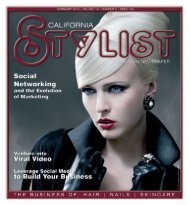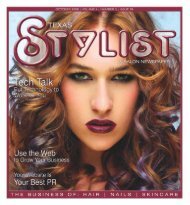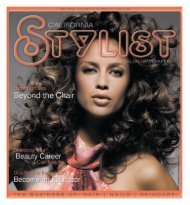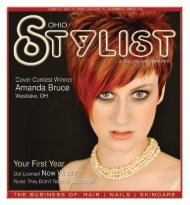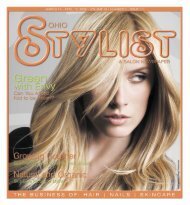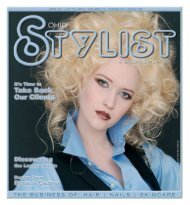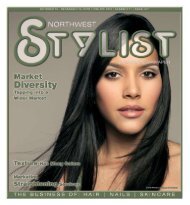0808 CA Stylist.indd - Stylist and Salon Newspapers
0808 CA Stylist.indd - Stylist and Salon Newspapers
0808 CA Stylist.indd - Stylist and Salon Newspapers
Create successful ePaper yourself
Turn your PDF publications into a flip-book with our unique Google optimized e-Paper software.
Nailpro Anaheim<br />
Nails-Only Trade Show<br />
It’s<br />
All<br />
You<br />
About<br />
Anaheim Convention Center<br />
September 14, 2008<br />
9 a.m. - 4:30 p.m.<br />
Register by August 29<br />
<strong>and</strong> SAVE!<br />
Call 888.491.8265 or<br />
visit nailpro.com<br />
No childreN uNder 12<br />
allowed iN Show<br />
Nailpro Cup 2008<br />
Competition Event<br />
Sponsored by<br />
2008<br />
10 | AUGUST 2008 | <strong>CA</strong>LIFORNIA STYLIST & SALON<br />
The Bene ts <strong>and</strong> Challenges of Hair Enhancement<br />
Blue Highways<br />
Jerry Tyler<br />
Hair enhancement is one of the fastest<br />
growing segments of the beauty industry.<br />
It’s important to be aware of the challenges<br />
that come with the major benefits <strong>and</strong> sudden<br />
dem<strong>and</strong> which affects both our clients <strong>and</strong> our<br />
fellow licensees.<br />
Most of these issues are already prevalent in<br />
parts of the nation; therefore, several states are<br />
already dealing with these issues proactively to<br />
protect the integrity <strong>and</strong> professionalism in this<br />
segment of the beauty industry.<br />
The financial rewards offered by hair<br />
enhancement can be truly amazing. Many hair<br />
enhancement technicians charge upward of<br />
$100 per hour for their services. A full-head<br />
weave can comm<strong>and</strong> from $300 to $2,000.<br />
Individual str<strong>and</strong>s can cost up to $10 per str<strong>and</strong>,<br />
with 100-300 str<strong>and</strong>s per full head. But with<br />
this source of financial potential comes responsibility—both<br />
toward the client <strong>and</strong> for our<br />
profession as a whole.<br />
The expansion “hair enhancement” falls<br />
into three categories based on the method of<br />
attachment. They are multiple str<strong>and</strong> placement,<br />
individual str<strong>and</strong> <strong>and</strong> non-surgical hair replacement.<br />
Multiple str<strong>and</strong> placement involves the<br />
placement of a hair weft attached by a sewn in<br />
(weave) method, multiple track micro link or<br />
latex bond. The advantage of this method is the<br />
lateral anchoring of the hair weft, which creates<br />
a durable secure bond that holds up to styling.<br />
Individual str<strong>and</strong> placement involves the<br />
placement of individual pre-bonded keratin<br />
str<strong>and</strong>s of various dimensions <strong>and</strong> lengths.<br />
Methods of attachment are individual micro<br />
link (no heat), fusion method (heat with purging<br />
iron) <strong>and</strong> thermal adhesion (melted keratin<br />
<strong>and</strong> gun method).<br />
The advantage of individual str<strong>and</strong> placement<br />
is that it is more natural <strong>and</strong> is easier to<br />
blend with the natural hair. Attachment of multicolor<br />
str<strong>and</strong>s allows the effect of highlighting<br />
without the use of hair color.<br />
With over 40 percent of the adult population<br />
experiencing some form of hair loss, either<br />
due to medical issues or part of the normal<br />
aging process, the dem<strong>and</strong> for non-surgical hair<br />
replacement is at all time high. Most HMOs<br />
<strong>and</strong> Preferred Provider Organizations (PPOs)<br />
now pay for hair replacement as part of their<br />
benefits for cancer <strong>and</strong> other patients who experience<br />
hair loss as part of treatment.<br />
The most prevalent forms of hair replacement<br />
are lace front units for woman <strong>and</strong><br />
custom full or partial hairpieces for men. The<br />
fabrication of these pieces requires specific<br />
training <strong>and</strong> the results, due to advances in technology,<br />
allow for maximum comfort, durability<br />
<strong>and</strong> a realistic look that is hard to detect.<br />
With the elevated dem<strong>and</strong> for these services<br />
has come an ever-increasing dem<strong>and</strong> for human<br />
hair. The dem<strong>and</strong> is so great the average price<br />
for human hair has risen 30 percent in the last<br />
few months.<br />
In the last two years, the amount of raw hair<br />
purchased for export from India to China went<br />
from $51 million to $250 million. Of that hair,<br />
80 percent went to the U.S. market.<br />
In China, where much of the hair is processed,<br />
a large portion of the supply has been<br />
diverted to create amino acids for food supplements,<br />
therefore adding to the shortage of hair<br />
available for enhancements—driving global<br />
prices upward. Unfortunately, while these<br />
prices are going up quality is going down.<br />
With such a high dem<strong>and</strong>, the current<br />
shortage <strong>and</strong> with no real controlling authority,<br />
some of the hair sold as human hair is mixed<br />
with synthetics or even animal hair. Since most<br />
of these suppliers carry an “all sales are final”<br />
policy, consumers have no recourse or assurance<br />
of quality.<br />
When in the ethnic market, a high percentage<br />
of all hair sales are made directly to the<br />
client, who then has their hair professional use<br />
them as part of their hair extension service. As<br />
most synthetic fibers are only heat resistant to<br />
200 degrees, imagine the unsuspecting client<br />
who applies a thermal hot iron at 350 degrees to<br />
what she thought was human hair. Or imagine<br />
the customer with animal allergies who just<br />
had animal hair attached to her head, which she<br />
though was 100 percent human hair. These are<br />
real issues of consumer concern.<br />
The solution to the above issue is simple.<br />
All hair sold should have a truth in advertising<br />
claim based on the material safety data sheet<br />
supplied by the importer, stating the nature<br />
of the hair as a certain percentage of human,<br />
synthetic or other hair. This way the consumer<br />
or licensee purchasing it for attachment knows<br />
what they are getting. The sheet should also<br />
state the point of origin. In the area of business<br />
ethics, a truth in advertising protocol in the sale<br />
of hair should be within the scope of regulation.<br />
The various methods of hair enhancement<br />
offer untold creative <strong>and</strong> technical advantages.<br />
This true both financially <strong>and</strong> in offering new<br />
<strong>and</strong> creative services—but only if we address<br />
the challenges that come with the territory.<br />
If we assure we use safe techniques that<br />
have long lasting results, we can enhance our<br />
services without compromising the integrity of<br />
the industry we have worked so hard to protect.<br />
Jerry Tyler has been a stylist since 1975 serving as the former artistic director for<br />
Vidal Sassoon Academy <strong>and</strong> currently as Director of Education for Carlton Hair<br />
salons. He is also a licensed cosmetology instructor <strong>and</strong> has served as President of<br />
the California State Board of Barbering <strong>and</strong> Cosmetology.



